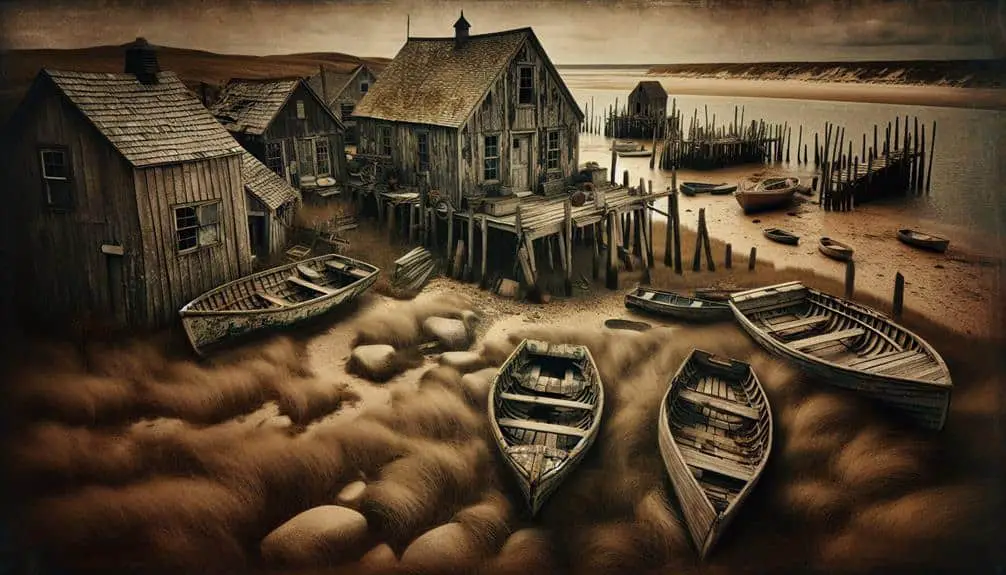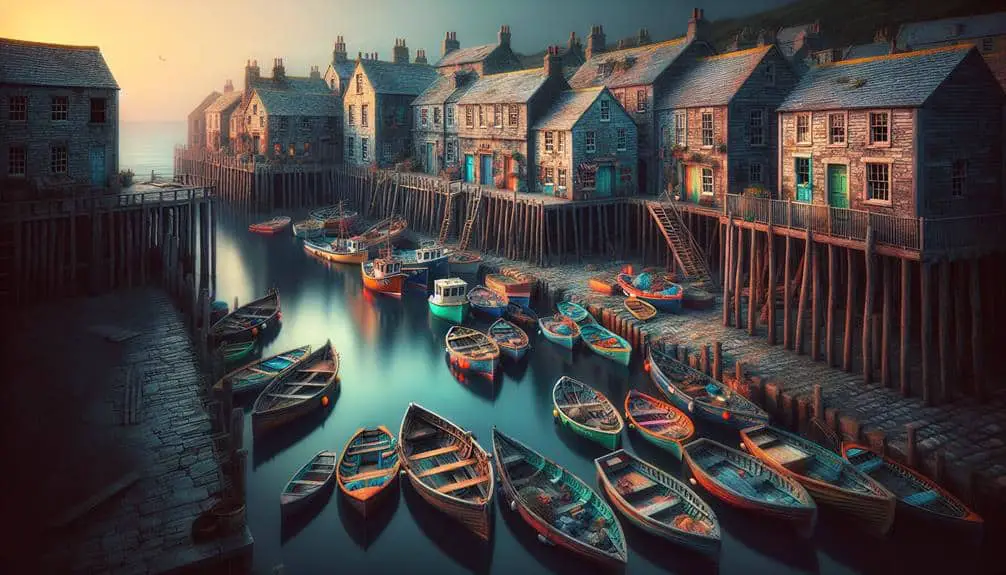Hidden coastal fishing ruins are significant as they provide a direct link to ancient maritime communities. They offer a unique glimpse into the customs and technologies of our ancestors. These ruins bridge the gap between past and present maritime traditions, showcasing a rich history of coastal life. By exploring these remnants, you uncover a world of cultural heritage and societal structures. Their existence speaks volumes about human innovation and environmental interconnectedness. The significance of hidden coastal fishing ruins goes beyond the surface, revealing layers of history waiting to be unraveled.
Key Points
- Tangible connection to ancient maritime communities, revealing rich maritime history.
- Preservation of remnants provides insights into past coastal lives and traditions.
- Cultural impact illuminates societal connections and anthropological insights.
- Environmental importance as pivotal ecological markers and marine biodiversity preservation.
- Tourism potential offers economic boost and sustainable income through historical intrigue.
Historical Significance of Coastal Fishing Ruins
The historical significance of coastal fishing ruins lies in their tangible connection to the ancient methods and traditions of maritime communities. Through archaeological exploration of these ruins, we gain valuable insights into the practices and way of life of our ancestors who relied on the sea for sustenance and livelihood. These remnants serve as physical evidence of the rich maritime history that has shaped coastal regions for centuries.
Delving into the ruins offers a unique opportunity to uncover the intricate systems and technologies employed by past fishing villages. By studying the layout of structures, tools, and artifacts found in these sites, researchers can piece together a clearer picture of how these communities operated and interacted with the sea. This insight not only enriches our understanding of maritime history but also sheds light on the resilience and resourcefulness of ancient coastal populations.
In essence, the archaeological exploration of coastal fishing ruins serves as a bridge between the past and the present, allowing us to appreciate the enduring legacy of maritime traditions that continue to influence coastal communities today.
Preservation of Coastal Fishing Village Remnants
Amidst the rugged beauty of coastal landscapes lie remnants of fishing villages that whisper tales of a bygone era, beckoning for preservation and study. These archaeological treasures hold the key to understanding the lives and traditions of past coastal communities. To guarantee their survival for future generations, active engagement from the community is essential.
Preserving coastal fishing village remnants involves a delicate balance between conservation and exploration. Archaeological examination of these sites not only reveals the daily activities and societal structures of these ancient communities but also sheds light on the evolution of fishing practices and maritime cultures. By engaging with these remnants, communities can reclaim their heritage and foster a sense of pride in their shared history.
Community involvement plays a crucial role in the preservation of these sites, as local participation ensures a sustainable approach to conservation efforts. Through education, awareness campaigns, and collaborative initiatives, individuals can actively participate in protecting and promoting these invaluable remnants of our coastal heritage. Together, we can safeguard these hidden coastal gems and continue to unravel the mysteries they hold.
Cultural Impact of Hidden Coastal Ruins
Uncovering the hidden coastal ruins illuminates the cultural tapestry woven by past communities, offering a glimpse into their traditions and ways of life. These remnants serve as windows into the societal connections and community remnants of ancient fishing villages.
Each artifact, each structure, holds anthropological insights waiting to be deciphered, shedding light on the daily lives, belief systems, and social structures of these coastal communities. By studying these ruins, we gain a deeper understanding of the cultural heritage embedded in these locations, appreciating the resilience and creativity of those who once thrived there.
The preservation of these sites not only safeguards historical treasures but also fosters a sense of connection to our collective past, bridging the gap between generations and preserving the richness of diverse cultural experiences. Hidden coastal ruins aren't merely relics of the past; they're living attestations to the enduring legacy of human innovation and adaptation in the face of changing environments.
Environmental Importance of Fishing Village Relics
Nestled along the rugged coastline, remnants of ancient fishing villages serve as pivotal ecological markers, revealing the interconnectedness between human activity and the surrounding environment. These relics offer more than historical insights; they provide essential ecological benefits. The vestiges of these villages contribute greatly to the preservation of marine biodiversity in coastal areas.
The structures of these fishing villages create artificial reefs that foster the growth of various marine species. The nooks and crevices of the ruins offer shelter for fish, crustaceans, and other marine organisms, promoting a thriving ecosystem. Additionally, the presence of these relics helps in the restoration of damaged marine habitats by acting as anchors for the growth of new coral formations and seaweed beds.
Tourism Potential of Coastal Fishing Ruins
The tourism potential of coastal fishing ruins lies in their ability to offer visitors a unique glimpse into the historical significance and cultural heritage of these ancient maritime communities. Exploring these ruins not only provides a window into the past but also presents an opportunity for economic boost in local communities. Tourists are drawn to the archaeological intrigue surrounding these hidden treasures, seeking to uncover the mysteries of the seas and the lives of those who once inhabited these coastal villages.
By promoting these coastal fishing ruins as tourist attractions, local communities can capitalize on their historical value, attracting visitors who are interested to investigate the stories etched within the stone foundations and remnants of old fishing vessels. This influx of tourists can stimulate local economies through increased spending on accommodations, dining, and souvenirs, thereby creating a sustainable source of income for the residents.
In essence, the tourism potential of coastal fishing ruins not only preserves the past but also fosters a sense of appreciation for the cultural heritage embedded within these ancient relics.
Frequently Asked Questions
How Do Experts Determine the Age of Hidden Coastal Fishing Ruins?
To determine the age of hidden coastal fishing ruins, experts use radiocarbon dating and stratigraphic analysis. By examining layers of sediment and organic materials, they can accurately pinpoint when these structures were constructed.
What Materials Were Typically Used in the Construction of Coastal Fishing Villages in the Past?
Craftsmen from the past often used sturdy stone and timber to construct coastal fishing villages. Their traditional techniques and skilled craftsmanship have left behind hidden ruins that reveal the ingenuity of ancient builders.
Are There Any Superstitions or Folklore Associated With These Hidden Coastal Ruins?
As you explore hidden coastal ruins, you'll encounter tales of superstitions and folklore linked to these ancient villages. Local legends intertwine with the ruins, adding mystery and intrigue to the history of these coastal communities.
How Do Coastal Fishing Ruins Contribute to the Biodiversity of Marine Ecosystems?
Coastal fishing ruins play an essential role in marine conservation by providing habitats for various species and promoting biodiversity. Their presence has a significant ecological impact, contributing to the health and balance of marine ecosystems.
Have Any Archaeological Discoveries Been Made in or Around These Fishing Village Remnants?
Excavation techniques like ground-penetrating radar and underwater archaeology have revealed fascinating artifacts around coastal fishing ruins. Discoveries include ancient tools, pottery, and even remnants of boats, shedding light on past civilizations.



